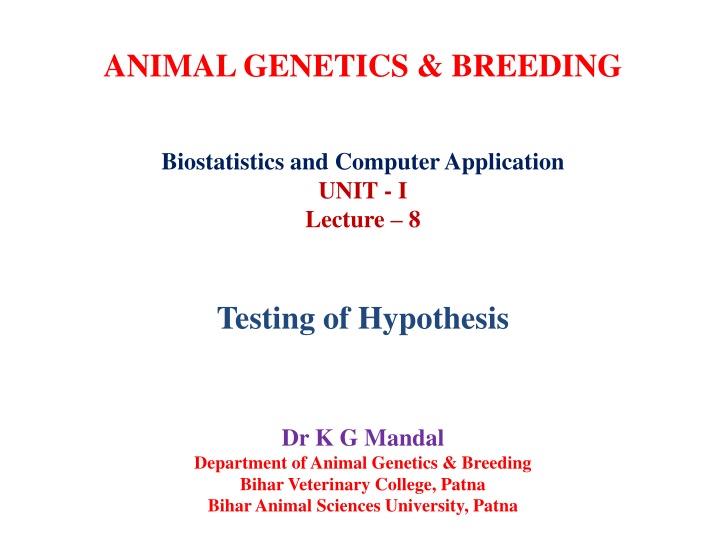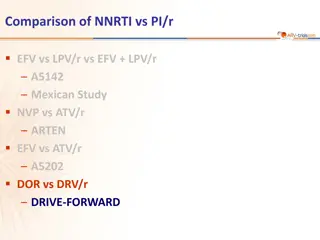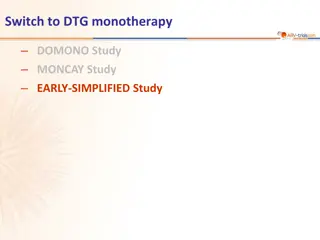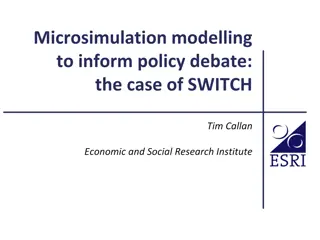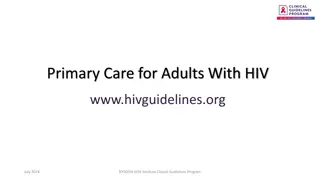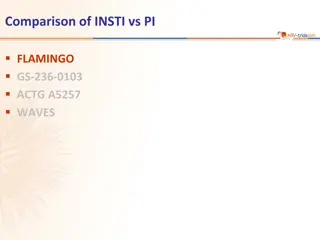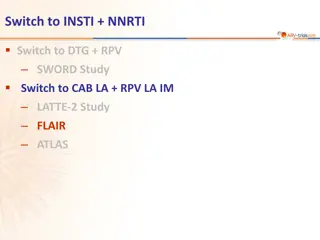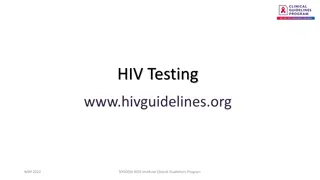Switch to DRV/r Monotherapy in HIV-Positive Adults: PROTEA Study Analysis
The PROTEA Study analyzed the efficacy of switching HIV patients to DRV/r monotherapy, comparing it with the standard triple therapy. The study focused on non-inferiority in achieving suppressed HIV RNA levels at week 48. Results showed that DRV/r monotherapy was not non-inferior to triple therapy, indicating further research is needed to establish its efficacy. Additionally, CNS sub-study outcomes and patient characteristics were documented to provide a comprehensive evaluation.
Download Presentation

Please find below an Image/Link to download the presentation.
The content on the website is provided AS IS for your information and personal use only. It may not be sold, licensed, or shared on other websites without obtaining consent from the author.If you encounter any issues during the download, it is possible that the publisher has removed the file from their server.
You are allowed to download the files provided on this website for personal or commercial use, subject to the condition that they are used lawfully. All files are the property of their respective owners.
The content on the website is provided AS IS for your information and personal use only. It may not be sold, licensed, or shared on other websites without obtaining consent from the author.
E N D
Presentation Transcript
ANIMAL GENETICS & BREEDING Biostatistics and Computer Application UNIT - I Lecture 8 Testing of Hypothesis Dr K G Mandal Department of Animal Genetics & Breeding Bihar Veterinary College, Patna Bihar Animal Sciences University, Patna
Testing of Hypothesis Hypothesis: Hypothesis assumption or a statement about a population. means simply an Statistically,Hypothesis means a quantitative statement or put forth certain values about a population under certain conditions.
Example, (i) the average height of the student is 65 . (ii) 65% people of the country are literate. (iii) During the last financial year India produced 100 million tonnes of milk. (iv) Tall and appeared in 3:1 monohybrid phenotypic ratio, etc. dwarf pea plant
Testing of hypothesis: Verification of the statement for its authenticity or examining the sample drawn from that population is known as testing of hypothesis. Example: x = 63 ( av. Height of man from a sample of 28 persons) = 65 (av. Height of man from a population of 1000 people). truthfulness by
Types of hypothesis Null hypothesis: The hypothesis of no difference. It is denoted as HO Alternative hypothesis: It is opposite to that of null hypothesis. It indicates that there is significant difference between sample estimates and population parameters. It is denoted as HA.
Setting up of null hypothesis:. HO : x = (sample mean = population mean) HA: x (Sample mean # population mean, sample does not represent the population) Test of significance : testing of null hypothesis It is a statistical procedure to decide whether HO should be rejected or accepted.
The HO is tested through sample results. It involves a procedure to know the significance of difference between estimates of two samples or of the difference between sample estimate and population parameter. This is called the test of significance.
Test statistic or test criteria It is a function of sample estimates. It provides information about population parameter. Various testes are : (i) Chi-square test for qualitative traits (ii) t & F test for quantitative traits Sample size may affect test of significance.
Suppose, x = sample mean = population mean HO : X = Test criteria used is (x - ) Z = ---------- / n
Errors in hypothesis testing: A decision is taken to accept or reject HO. This involves a risk to take the wrong decision. Type I Error It is the error of rejecting HO when it is true. Probability of rejecting HO when it is true. Type II Error: It is the error of accepting HO when it is false. Probability of accepting HO when it is false.
Level of significance: The level of significance is the level possible error that the statistician may commit in drawing inference in testing of HO. Generally 5% and significance are considered in taking the decision. conclusion or 1% level of
5% LS means 95% is true and there is an error of 5% only. Hence, the decision of rejecting HO is correct to the extent of 95% confidence. 1% LS means 99% is true and there is an error of 1% only. Hence, the decision of rejecting HO is correct to the extent of 99% confidence.
Principles of interpretation: (i) If the calculated value of a given test (x2, t, F) for a given degree of freedom and level of significance is more than the tabulated value at the corresponding degree of freedom significance, then the difference is said to be significant and null hypothesis may be rejected. (ii) and level of
If the calculated value is < the tabulated value for a given degree of freedom and level of significance than the tabulated corresponding level of significance and degrees of freedom then there is no significant difference between sample estimate and population parameter and null hypothesis may be accepted. value for the
